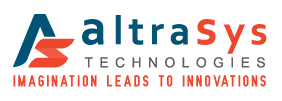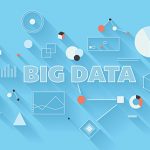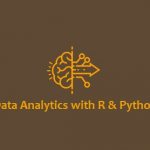Data Analytics with R and Python
Learn Data Science with R and Python
Data Science with R
A survey in 2014 found, for many R is the most common choice of first language to work with Data Science. It is a true statistical programming language used to build various techniques for analysis and manipulation to gain actionable insights in data just writing few lines of code. The course is designed to cover major R skills that are needed to build strong foundation to prepare the students for more in-depth analytical power later use in their career, where concepts and applications such as probability, distributions, inference, regression and machine learning in predictive analytics for problem solving. The course includes simulated real-life projects, case studies, and includes R and R Studio for practice.
Data Science with Python
Python is a great choice for data science and is in high demand in today’s industry scenario. Keeping these requirements in mind this course has been designed to train the students to meet industry demand. The course is having single objective to provide a comprehensive learning path to students new to python for data analysis. Python is recommended to new learner who want to enter the Big Data or data science fields in big way. Many people say Python is easy to learn and debug yet it is considered as a high-level programming language preferred choice because with less code is writing to solve complex problem because of the language’s user-friendly features and simple syntax.
R or Python – which is the preferred choice for data analysis?
It is hard to tell which flavour is good and tasty as a tool for data analysis. Both the languages do have their supporters and opponents.
- Both are open source languages
- While R’s functionality is developed with statisticians in mind, Python is often liked for being a general-purpose language with an easy-to-understand syntax.
- Python is better for data manipulation and repeated tasks, while R is good for ad hoc analysis and exploring datasets.
- Popular opinion being, R has a steep learning curve, and people without programming experience may find it overwhelming, whereas Python is generally considered easier to grasp.
- Python integrates with big data, hadoop and spark
- R also integrates well with other computer languages like C++, Java, and C.
The bottom line – most of the common tasks associated with one or is also doable with other
Of late the great R-versus-Python debate is settled. If all you’re doing is data analysis, it doesn’t really matter which is to choose
The guidelines that determine self-choice is the personal preferences, project requirements, collaboration, community support and of course market demand
Why train R and Python with us?
- 80-20 focus on practical & theory
- Result oriented course structure
- Personal attention and access to individual counseling
- Industrywide accepted best practices
- Course content caters to standard certification
- Training imparted by professionals of industry repute both training, development, and implementation. The knowledge acquired is used immediately in the life project
- The training course provides all requisites for practical implementations of machine learning algorithms in data analytics and visualizations using various concepts and case studies
At end of training, students learn how to
- Become better at devising data-driven solutions to challenging Biz problems
- Explore and examine data from a variety of sources to gain actionable insights
- Apply different statistical and analytics techniques, using
-
- Supervised/Unsupervised machine learning
- Regression
- Classification
- Clustering
- Factoring
- Customer preference – Conjoint analysis
- Text Mining / Sentiment Analysis
- Natural Language processing (NLP)
- Association Rule learning/ PCA
- Artificial Neural Networks (ANN)
- Deep Learning
- Visualize the outcome of data analysis
- Apply analytics in various industry domains
Data Science with R Duration: 80 Hours
- An Overview of Analytics & Data Science
- Introduction to Statistics
- Introduction to Predictive Modeling concept
- Data Exploration for modeling
- Data Preparation
- Introduction – Data Importing/Exporting
- Data Manipulation
- Data Analysis – Visualization (Intro to Exploratory Data Analysis)
- Segmentation: Solving segmentation problems
- Linear Regression: Solving regression problems
- Time Series Forecasting: Solving forecasting problems
- Machine Learning -Predictive Modeling – Basics
- Unsupervised Learning: Segmentation
- Supervised Learning: Decision Trees
- Supervised Learning: Ensemble Learning
- Supervised Learning: Artificial Neural Networks (ANN)
- Supervised Learning: Support Vector Machines (SVM)
- Supervised Learning: K-NN
- Supervised Learning: Naïve Bayes
- Text Mining & Analytics
Important R Packages (These packages are covered while learning respective topics)
- R Packages for data manipulation(base, dplyr, plyr, data.table, reshape, car, sqldf, etc)
- R Packages for Exploratory Data Analysis(dplyr, plyr, gmodes, car, vcd, Hmisc, psych, doby etc)
- R Packages for Graphical Analysis (base, ggplot, lattice,etc)
- R Packages for Machine Learning (caret, H2O, Randomforest, nnet, tm etc)
Data Science with PythonDuration: 80 Hours
- An Overview of Analytics & Data Science
- Introduction to Statistics
- Basic statistics & implementation of stats methods in python
- Introduction to Predictive Modeling concept
- Data Exploration for modeling
- Data Preparation
- Introduction – Data Importing/Exporting
- Data Manipulation
- Data Analysis – Visualization (Intro to Exploratory Data Analysis)
- Segmentation: Solving segmentation problems
- Linear Regression: Solving regression problems
- Time Series Forecasting: Solving forecasting problems
- Machine Learning -Predictive Modeling – Basics
- Unsupervised Learning: Segmentation
- Supervised Learning: Decision Trees
- Supervised Learning: Ensemble Learning
- Supervised Learning: Artificial Neural Networks (ANN)
- Supervised Learning: Support Vector Machines (SVM)
- Supervised Learning: K-NN
- Supervised Learning: Naïve Bayes
- Text Mining & Analytics
Python Essentials (Core)
- Scientific distributions used in python for Data Science
- Numpy, scify, pandas, scikitlearn, statmodels, nltk etc
- Accessing/Importing and Exporting Data using python modules
- Data Manipulation – cleansing – Munging using Python modules
- Important Python modules for data manipulation (Pandas, Numpy, re, math, string, datetime etc)
- Data Analysis – Visualization using Python
- Important Packages for Exploratory Analysis(NumPy Arrays, Matplotlib, seaborn, Pandas and scipy.stats etc)
- Important modules for statistical methods: Numpy, Scipy, Pandas
Why should I learn Big Data Hadoop and Spark from altraSys?
- Students learn from the Industry specialist with long stretch of training experiences
- Learning becomes comprehensive as the training is through collection of case–studies, hand-picked problem instances that helps students to gain in-depth understanding of how data science assists decision making process
- Students learn analytics tool to crack business and industry specific problems (is detailed out comprehensive training brochure)
This training course content has been so deigned to align with OEM certification curriculum.








